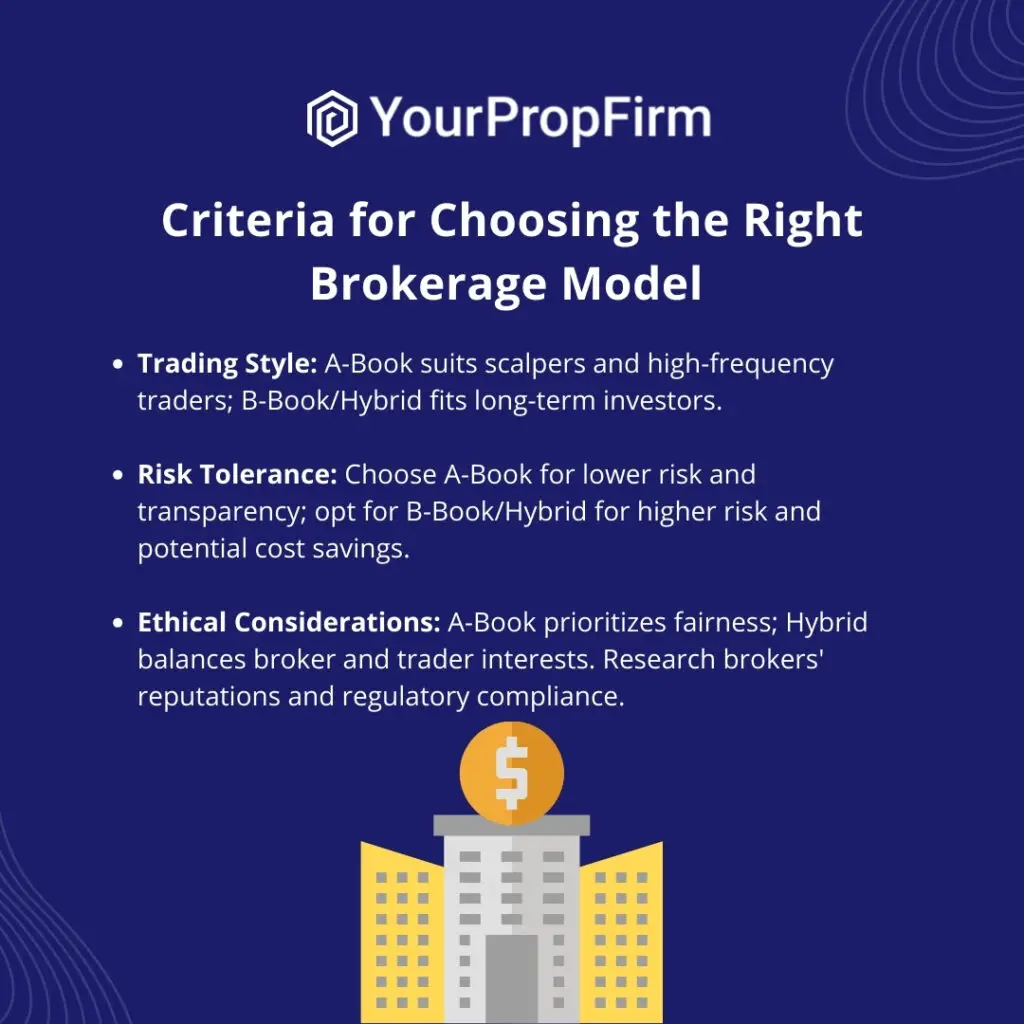Introduction to Brokerage Models in Forex Trading
Brokerage models are frameworks used by brokers to handle and execute trades for their clients in the forex market. These models significantly influence how trades are processed and the overall trading experience for individual traders.
In the forex market, there are three main types of brokerage models: A-Book, B-Book, and Hybrid. Each model plays a crucial role in determining how trades are executed, how risks are managed, and the overall transparency of the trading process. Understanding these models helps traders make informed decisions about which brokers to work with based on their trading preferences and risk tolerance.
Overview of Brokerage Models
Brokerage models in forex trading serve as the architectural frameworks that define the relationship between brokers and traders. These models dictate how trades are executed, how risks are managed, and how brokers interact with the wider market.
1. Market Transparency
Different brokerage models affect the level of transparency in trading. For instance, A-Book models offer higher transparency since trades are routed directly to liquidity providers. In contrast, B-Book models may lack this transparency because the broker acts as the counterparty to trades.
2. Fairness
The choice of brokerage model can influence the perceived fairness of trading. A-Book brokers, who pass trades directly to the market, are seen as more fair since they do not profit from clients’ losses. On the other hand, B-Book brokers might face conflicts of interest since they benefit when traders lose.
3. Integrity
The integrity of the trading process is also shaped by the brokerage model. Hybrid models attempt to balance the benefits of both A-Book and B-Book systems, aiming to provide a fair and transparent trading environment while managing risks effectively. This can enhance the overall integrity of the trading process by aligning the interests of both brokers and traders.
A-Book Brokerage Model (Straight Through Processing)
The A-Book model operates as a pass-through mechanism for traders’ orders to financial markets. Brokers using this model route their clients’ trades directly to liquidity providers, such as banks or other financial institutions, without intervening.
Operational Mechanics
Brokers using the A-Book model connect traders directly to the financial markets. They do not take the opposite positions of their clients’ trades, which means they do not profit from client losses. Instead, these brokers act as intermediaries, facilitating transactions between traders and liquidity providers.
Revenue Generation
A-Book brokers earn revenue from commissions and spreads. They charge a small fee per trade (commission) and may also earn from the difference between the bid and ask prices (spread). This model maintains transparency since traders can see the actual market prices and know how much they are paying for each trade.
Pros and Cons
Pros:
- Enhanced transparency
- Minimized conflict of interest
- Favorable for traders using complex strategies
Cons:
- Brokers have limited control over market prices and liquidity
- Dependency on external liquidity providers
B-Book Brokerage Model (Market Maker)
The B-Book model is a brokerage system where brokers take the opposite side of traders’ trades. In this model, brokers act as market makers, meaning they provide liquidity by being the counterparty to their clients’ transactions.
Risk Management
Brokers manage risks associated with being the counterparty by employing risk management strategies such as hedging. They may offset their exposure by taking positions in the actual market or by using various financial instruments to mitigate potential losses from client trades.
Potential Conflicts
The B-Book model can create conflicts of interest because brokers profit when traders lose. This conflict might affect traders as brokers might be tempted to manipulate prices or engage in practices that are not in the best interest of their clients.
Pros and Cons
Pros:
- Potential for higher profits for the broker
- Ability to offer lower transaction costs to traders
Cons:
- Inherent conflict of interest
- Potential for price manipulation
Hybrid Brokerage Model
The Hybrid model combines elements of both A-Book and B-Book models. This approach allows brokers to decide, based on various criteria, whether to pass traders’ orders directly to the market or to keep them in-house.
Decision Criteria
Brokers using the Hybrid model decide whether to pass orders to the market or keep them in-house based on their risk management strategies and prevailing market conditions. Factors influencing this decision include the size of the trade, the trader’s profile, and the broker’s assessment of potential risks and rewards.
Balanced Approach
The Hybrid model attempts to balance the benefits of both A-Book and B-Book systems. By selectively routing orders, brokers can offer transparency and minimized conflicts of interest for certain trades, while also managing risk and potentially increasing profitability by acting as market makers for other trades.
Pros and Cons
Pros:
- Flexibility in order handling
- Tailored approach to different trader profiles
Cons:
- Complexity in management
- Higher operational costs
Evolution of Brokerage Models
The development of brokerage models has evolved significantly over time. Initially, the industry was dominated by the B-Book model, where brokers acted as market makers. Over the years, the rise of the A-Book and Hybrid models was driven by a demand for greater transparency, fairness, and better risk management.
Historical Development
- Predominantly B-Book: In the early days of forex trading, most brokers operated under the B-Book model. This model allowed brokers to provide liquidity and profit from traders’ losses, but it also raised concerns about conflicts of interest and price manipulation.
- Rise of A-Book: As traders became more sophisticated and demanded greater transparency, the A-Book model gained popularity. This model routes trades directly to liquidity providers, reducing the potential for conflicts of interest and providing more transparent pricing.
- Hybrid Models: The development of Hybrid models emerged as brokers sought to balance the benefits of both A-Book and B-Book systems. By selectively routing trades, brokers could offer transparency and minimize conflicts for some trades while managing risk and profitability for others.
Technological Advancements and Regulatory Changes
Technological advancements have played a crucial role in shaping current brokerage practices. Improved trading platforms, faster execution speeds, and better risk management tools have enabled brokers to implement more sophisticated models. Additionally, regulatory changes have pushed the industry towards greater transparency and fairness, encouraging the adoption of A-Book and Hybrid models. Enhanced regulatory frameworks aim to protect traders and ensure that brokers operate with integrity, further influencing the evolution of brokerage models.
Choosing the Right Brokerage Model

Selecting the right brokerage model depends on your trading strategies, risk tolerance, and ethical considerations.
Criteria for Choosing the Right Model
Traders using strategies like scalping and high-frequency trading may prefer the A-Book model for its direct market access and transparent pricing. Long-term investors might find the stability of B-Book or Hybrid models more beneficial. If you have a low risk tolerance, the A-Book model, where trades are passed directly to the market, could be a better choice. Those comfortable with higher risks might opt for B-Book or Hybrid models, which offer potentially lower transaction costs and more flexible trading conditions.
Ethical considerations are also important. If you prioritize transparency and fairness, the A-Book model is preferable since brokers do not profit from client losses. For a balanced approach, the Hybrid model can be a good fit, combining elements of both A-Book and B-Book models to better align broker and trader interests.
Guidelines for Assessing Suitability
First, evaluate your trading needs. Are you a high-frequency trader, a scalper, or a long-term investor? Your trading style heavily influences which model suits you best. Next, assess your risk tolerance. If you prefer lower risks and greater transparency, an A-Book model might be more suitable. For those willing to accept higher risks for potentially lower costs, a B-Book or Hybrid model could be appropriate.
Research the reputation and practices of brokers to ensure they align with your ethical standards and trading goals. Look for brokers with transparent practices and positive reviews from other traders. Additionally, check if the broker adheres to relevant regulatory standards, providing an added layer of security and trust in the broker’s operations.
Frequently Asked Questions (FAQ)
What are the key differences between A-Book and B-Book brokerage models?
The A-Book model routes traders’ orders directly to the financial markets, acting as an intermediary without taking the opposite side of trades. This model offers higher transparency and minimizes conflicts of interest. In contrast, the B-Book model has brokers act as market makers, taking the opposite side of traders’ orders. This can lead to conflicts of interest, as brokers profit when traders lose.
How do Hybrid models decide when to use A-Book vs. B-Book strategies?
Hybrid models use a combination of criteria to decide whether to pass orders to the market (A-Book) or keep them in-house (B-Book). These criteria include the size of the trade, the trader’s profile, and market conditions. Brokers assess potential risks and rewards to determine the most suitable approach for each trade, balancing transparency and risk management.
What are the implications of each model on a trader’s profitability and risk?
In the A-Book model, traders benefit from greater transparency and reduced conflicts of interest, which can enhance profitability through fair market prices. However, traders are exposed to market risks and liquidity variations. In the B-Book model, traders might enjoy lower transaction costs, but face potential conflicts of interest and the risk of price manipulation. Hybrid models aim to offer a balanced approach, providing transparency for some trades while managing risk and costs for others. This can lead to a more tailored trading experience, but with added complexity.
Conclusion and Further Resources
Understanding different brokerage models in Forex trading is crucial for traders and brokers alike. The choice of model—A-Book, B-Book, or Hybrid—directly impacts transparency, risk management, and overall trading success. By selecting the right model based on their trading strategies and risk tolerance, traders can optimize their trading experience and outcomes.
For those interested in deepening their understanding of brokerage models, several resources are available. Consider reading books on forex trading strategies and brokerage practices, such as “The Forex Trading Manual” by Javier Paz. Online courses and seminars offered by institutions like the Online Trading Academy and Investopedia can provide more detailed insights. Additionally, participating in webinars and workshops hosted by experienced traders and brokers can offer practical knowledge and tips.




